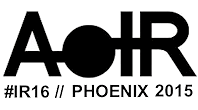 I recently attended the annual Association of Internet Researchers (AOIR) conference in
I recently attended the annual Association of Internet Researchers (AOIR) conference in
Phoenix, AZ. It was a great conference that I would highly recommend to anyone interested in learning first hand about research questions, methods, and studies broadly related to the Internet.
Researchers presented on a wide range of topics, across a wide range of media, using both qualitative and quantitative methods. You can get an idea of the range of topics by looking at the conference schedule.
I’d like to briefly share some of my key takeaways. I apologize in advance for oversimplifying what was a rich and deep array of research work, my goal here is to provide a quick summary and not an in-depth review of the conference.
-
Digital Methods Are Where It’s At
I attended an all-day, pre-conference digital methods workshop. As a testament to the interest in this subject, the workshop was so overbooked they had to run three concurrent sessions. The workshops were organized by Axel Bruns, Jean Burgess, Tim Highfield, Ben Light, and Patrik Wikstrom (Queensland University of Technology), and Tama Leaver (Curtin University).
Researchers are recognizing that digital research skills are essential. And, if you have some basic coding knowledge, all the better.
At the digital methods workshop, we learned about the “Walkthrough” method for studying software apps, tools for “web scraping” to gather data for analysis, Tableau to conduct social media analysis, and “instagrammatics,” analyzing Instagram.
FYI: The Digital Methods Initiative from Europe has tons of great information, including an amazing list of tools.
-
Twitter API Is also Very Popular
There were many Twitter studies, and they all used the Twitter API to download tweets for analysis. Although researchers are widely using the Twitter API, they expressed a lot of frustration over its limitation. For example, you can only download for free up to 1% of the total Twitter volume. If you’re studying something obscure, you are probably okay, but if you’re studying a topic like #jesuischarlie, you’ll have to pay to get the entire output. Many researchers don’t have the funds for that. One person pointed out that it would be ideal to have access to the Library of Congress’s Twitter archive. Yes, agreed!
-
Social Media over Web Archives
Researchers presented conclusions and provided commentary on our social behavior through studies of social media such as Snapchat, Twitter, Facebook, and Instagram. There were only a handful of presentations using web archived materials. If a researcher used websites, they viewed them live or conducted “web scraping” with tools such as Outwit and Kimono. Many also used custom Python scripts to gather the data from the sites.
-
Fair Use Needs a PR Movement
There’s still much misunderstanding about what researchers can and cannot do with digital materials. I attended a session where the presenter shared findings from surveys conducted with communication scholars about their knowledge of fair use. The results showed that there was (very!) limited understanding of fair use. Even worse, the findings showed that those scholars who had previously attended a fair use workshop were even more unlikely to understand fair use! Moreover, many admitted that they did not conduct particular studies because of a (misguided) fear of violating copyright. These findings were corroborated by the scholars from a variety of fields who were in the room.
-
Opportunities for Collaboration
I asked many researchers if they were concerned that they were not saving a snapshot of websites or Apps at the time of their studies. The answer was a resounding “yes!” They recognize that sites and tools change rapidly, but they are unaware of tools or services they can use and/or that their librarians/archivists have solutions.
Clearly there is room for librarians/archivists to conduct more outreach to researchers to inform them about our rich web archive collections and to talk with them about preservation solutions, good data management practices and copyright.
Who knew?
Let me end with sharing one tidbit that really blew my mind. In her research on “Dead Online: Practices of Post-Mortem Digital Interaction,” Paula Kiel presented on the “digital platforms designed to enable post-mortem interactions.” Yes, she was talking about websites where you can send posthumous messages via Facebook and email! For example, https://www.safebeyond.com/, “Life continues when you pass… Ensure your presence – be there when it counts. Leave messages for your loved ones – for FREE!”
By Rosalie Lack, Product Manager, California Digital Library

